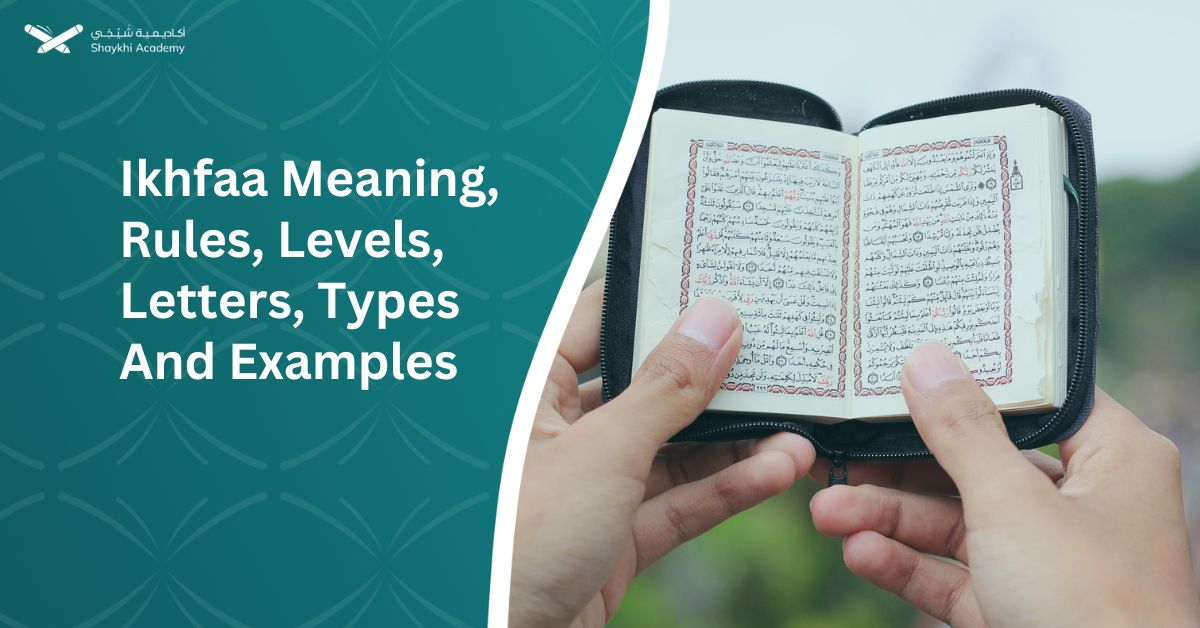Ikhfaa, an essential rule in Tajweed, involves concealing the pronunciation of certain consonants when preceded by noon sakinah or tanween. It represents a state between clear pronunciation (Izhar) and assimilation (Idgham), maintaining the ghunnah sound in the hidden letter.
The rule applies to 15 specific letters and is categorized into two types: Ikhfaa Haqiqi and Ikhfaa Shafawi. Understanding the levels, letters, and types of Ikhfaa is crucial for accurate Quranic recitation.
The rules of Tajweed in the Holy Quran are important and varied, and among these important rules is the rule of Ikhfaa. So what is it?
What is the meaning of Ikhfaa in Arabic?
Ikhfaa in the Arabic language means concealment, as it is said: The man disappeared from the eyes of people, that is, he concealed himself from them. Terminologically, it is: pronouncing a consonant, unstressed, in a form between Izhar and Idgham, while the ghunnah remains in the first letter (noon sakinah or tanween). This letter has ghunnah by the amount of two vowels, and it is one of the rules of the noon sakinah and tanween.
What is Ikhfaa in Tajweed?
Ikhfaa is a state between Ikhfaa and Idgham, it does not completely match the Izhar in achieving the pronunciation of the Noon, nor is it like Idgham, which requires similarity between the assimilated and the assimilated in it.
Ikhfaa means pronouncing the noon as a sakinah or tanween in a way between the Izhar and the Idgham, taking into account that the ghunnah remains in the hidden letter.
What are the 15 letters of Ikhfaa?
We previously mentioned to you a simplified method for memorizing the Ikhfaa letters by memorizing the letters of other rules, such as Izhar and Idgham, for example. Let us now clarify specifically what are the hidden letters in Tajweed?
There are fifteen letters included in the Ikhfaa rule, these letters are ك (Kaf), ق (Qaf), ف (Fa), ظ (Dhadh), ط (Taa), ض (Dhaad), ش (Sheen), س (Seen), ز (Zain), ذ (Tha), د (Dal), ج (Jeem), ث (Tha), ت (Ta). They are called Ikhfaa letters because they involve hiding or concealing the sound while pronouncing them.
How to learn Ikhfaa letters?
There are 4 main rules in Tajweed, which are Izhar, Idgham, Iqlab, and Ikhfaa. To make it easier to memorize the letters in each rule and not mix them, you can memorize them as follows:
There are 6 letters for Izhar rule: Ha (ه), Haa (ح), Khaa (خ), Hamza ((ء, Ain (ع), and Ghain (غ).
As for the Idgham, it also has 6 letters, which are the meem (م), the noon (ن), the ra (ر), the lam (ل), the waw (و), and the yaa (ي).
The Iqlab includes only one letter, which is the ba (ب).
As for the rest of the letters, they all fall under the rule of Ikhfaa.
What are The Types of Ikhfaa?
There are two types of Ikhfaa which are Ikhfaa Haqiqi and Ikhfaa Shafawi.
1- Ikhfaa Haqiqi:
It’s to conceal the sound of noon sakinah or tanween if it is followed by one of the fifteen specific Arabic letters we mentioned above.
Examples:
أنذرناكم”” We have warned you.
“ينفخ” The Horn is blown.
“يتيماً فآوى” takes refuge an orphan.
“من طغى” Whoever transgressed.
2- Ikhfaa Shafawi:
It refers to concealing the sound of the Arabic letter meem sakina when it is followed by the letter baa.
This type of Ikhfaa occurs because the letter Meem (م) shares the same place of pronunciation (sound production) as the letter B (ب), which is pronounced with the lips.
Examples:
“هم بالساهرة” – They are awake.
“صاحبكم بمجنون” – Your companion is not mad.
“كنتم به” – You used to be with him.
“عليهم بمصيطر”- He is Dominant over them.
“ربهم بذنبهم” – Their Lord is aware of their sins.
“ترميهم بحجارة” – You throw them with stones.
What are the Levels of Ikhfaa in Tajweed?
There are three levels of the real concealment (Ikhfaa Haqiqi):
1- The High Level:
This rank is achieved when the letter dal (د), ta (ط), or taa (ت) comes after the noon sakinah or tanween, and Ikhfaa here is closest to Idgham.
2- The Low Level:
This rank is achieved when the letters qaf (ق) and kaf (ك) come after the noon sakinah or tanween, and Ikhfaa here is close to Izhar.
3- The In-Between Level:
This level is called Ikhfaa Ausath and it is achieved when the remaining letters of Ikhfaa come after the noon sakinah or tanween.
What are the Rules of Ikhfaa in Tajweed?
The rule of Ikhfaa in Tajweed is easy and simple and is as follows:
If any of the fifteen letters of Ikhfaa are preceded by the Noon Sakinah or Tanween, then the Noon Sakinah and Tanween must be hidden when they are pronounced by making the Ghanna sound for approximately two beats of seconds.
Examples:
The letter Sad (ص) (أَنْ صَدُّوكُمْ) – (رِيحاً صَرْصَراً).
The letter dhal (ذ) (وَأَنْذِرْهُمْ) – (ظِلٍّ ذِي).
The letter thaa (ث) (مِنْ ثَمَرَةٍ) – (قَوْلاً ثَقِيلاً).
The letter kaf (ك) (الْمُنْكَرِ) – (كِتَابٌ كَرِيمٌ).
The letter Jeem (ج) (إِنْ جَاءَكُمْ) – (خَلْقٍ جَدِيدٍ).
The letter Sheen (ش) (فَأَنْشَرْنَا) – (غَفُورٌ شَكُورٌ).
The letter Qaf (ق) (مِنْ قَرَارٍ) – (سَمِيعٌ قَرِيبٌ).
The letter Seen (س) (الإِنْسَانُ) – (وَرَجُلاً سَلَماً).
The letter Dal (د) (مِنْ دَابَّةٍ) – (كَاْسَاً دِهاقاً).
The letter ta (ط) (بِقِنْطَارٍ) – (صَعِيداً طَيِّباً).
The letter Zai (ز) (مِنْ زَوَالٍ) – (صَعِيداً زَلَقاً).
The letter Faa (ف) (فَانْفَلَقَ) – (خَالِداً فِيهَا).
letter taa (ت) (وَمَنْ تَابَ) – (جَنَّاتٍ تَجْرِي).
The letter dād (ض) (مَنْضُودٍ) – (وَكُلاً ضَرَبْنَا).
The letter dha(ظ) (مِنْ ظَهِيرٍ) – (ظِلاًّ ظَلِيلاً).
How to Recognize the Ikhfaa Rule in the Moshaf?
We can easily recognize the rule of Ikhfaa while reading the Holy Quran through two distinctive signs:
1- When you meet what we call the (naked noon), it means the noon that appears without any of the phonetic signs (kasra, dhamma, and fatha). This means that there is nothing above it at all.
2- When we find the tanween above or below the letter, whether the tanween is fatha, dhammah, or kasra, and its shape is a doubling of the basic signs in the formation of letters (fatha – kasra – damma), and the letter that follows it does not have a stress (shaddah).
In these two cases, you can understand that there is an Ikhfaa rule that must be observed in reading.
What are the Common Mistakes Relating to Al-Ikhfaa Rule?
There are some common mistakes related to the rule of Ikhfaa in Tajweed include:
1- Over-exaggeration:
Sometimes, learners tend to overdo the concealment of the sound, making it too subtle or completely silent. The sound should still be audible, albeit subdued.
2- Ignoring Proper Pronunciation:
Some may neglect to pronounce the letter with the correct articulation before applying the rule of Ikhfaa’. Each letter should be pronounced clearly before considering the Ikhfaa’ rule.
3- Misapplication:
Applying Ikhfaa where it shouldn’t be applied or failing to apply it where necessary can lead to mistakes. It’s important to understand the specific conditions under which Ikhfaa’ occurs.
4- Confusion with other rules:
Learners might confuse Ikhfaa with other rules of Tajweed, such as Idgham (assimilation) or Izhar (clear pronunciation). It’s crucial to differentiate between these rules and apply them appropriately.
5- Inconsistent Pronunciation:
In some cases, learners may pronounce certain letters with Ikhfaa’ inconsistently throughout the recitation, leading to an irregular flow and disrupting the rhythm of the recitation.
6- Lack of Practice:
Insufficient practice can lead to mistakes in applying the rule of Ikhfaa’. Regular practice under the guidance of a knowledgeable teacher is essential to master Tajweed rules effectively.
By being aware of these common mistakes and actively working to avoid them through practice and understanding, learners can improve their recitation skills and adhere more closely to the rules of Tajweed.
Master Tajweed With Shaykhi
Remember, mastering Tajweed requires practice and guidance from a qualified teacher to ensure correct pronunciation and application of rules like Ikhfaa, and that’s precisely what Shaykhi Academy provides you with through its qualified teachers from the best universities and institutes specialized in teaching the science of Tajweed with all its rules.
Why Choose Shaykhi Academy?
- Connect with highly qualified native tutors.
- Flexible scheduling to suit your busy lifestyle.
- Affordable classes tailored for all levels.
- Accessible from anywhere around the globe.
Discover Our Range of Courses:
- Arabic Noorani Qaida: Lay a solid foundation for Quranic studies.
- Online Quran Classes for Kids: Engaging lessons for lifelong learning.
- Tajweed Rules for Kids: Learn to recite with confidence.
- Quran Hifz for Kids: Step-by-step guidance to memorize the Quran.
- Quran for Adults: Introduce yourself to Quran reading and Tajweed rules.
- Online Arabic Courses: Master the language of the Quran.
- Islamic Studies: A wide range of topics related to Islam, including theology, law, Quranic studies, Hadith.
Don’t Miss Out on Your Chance to Excel!
Whether you’re a beginner or seeking advanced knowledge, Shaykhi Academy can guide you! Book your free trial now and make Ramadan 2024 your Quranic turning point!
You can view the Tajweed course here and make up your mind. Apply now and get a free trial session from Shaykhi Academy.
Concluding Statement:
Mastering the rule of Ikhfaa in Tajweed is integral to achieving precise and melodious Quranic recitation. By recognizing common mistakes, practicing diligently, and seeking guidance, learners can refine their skills and deepen their connection with the sacred text, ensuring faithful adherence to the principles of Tajweed.




















